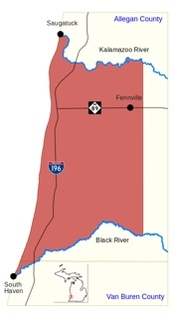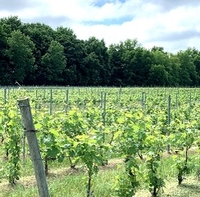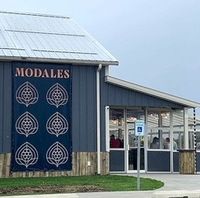Let’s start with a United States AVA trivia quiz (answers are at the end of the column):
In which state are the following AVAs located?
A) Covelo
B) Verde Valley
C) White Bluffs
D) Swan Creek
If you know them all, you are entitled to claim wine trivia wizard status. As of August 2022, there were 267 AVAs in the United States. Many of them are very well known, but an equal number are quite obscure. Most of the unknown group do not contain large commercial wineries and some are quite small in areal extent and vineyard acreage. AVAs are recognized by the Alcohol and Tobacco Tax and Trade Bureau (TTB) and are defined based not on wine production levels, but on their unique geographic features, climate, and soil conditions that contribute to distinctive wine characteristics.
The Fennville American Viticultural Area (AVA) is definitely one of the unknowns. It was established in 1981 and was the third AVA in all of the US, just behind Augusta, Missouri and Napa Valley. So, what is it about Fennville that makes it distinctive? Let’s look at some of the basics of this American Viticultural Area.
The law establishing the AVA category states:
“Section.9.11, Title 27 CFR, defines an American viticultural area as a delimited grape-growing region distinguishable by geographic features. Section4.25a(e)(2) outlines the procedures for proposing an American viticultural area. Any interested person may petition ATF to establish a grape- growing region as a viticultural area.”
Thus, the Fenn Valley Winery of Fennville, Michigan, petitioned ATF to establish a viticultural area to be named "Fennville." The story is told that the Fennville AVA was applied for because of frustration with getting all wineries to agree on a larger Lake Michigan Shore AVA. The Lake Michigan Shore AVA was subsequently approved in 1983 and encompasses the Fennville AVA.

Map of the Fennville AVA
The Fennville AVA itself includes some 75,000 acres of land. It is bounded by Lake Michigan on the west, the Kalamazoo River on the north, the Black River on the South, and the 86 5’ west longitude meridian on the east.
Testimony at the public hearing identified some of the characteristics that make Fennville distinct. Its proximity to Lake Michigan has a significant moderating effect on the climate. The Fennville area has average winter temperatures that are two degrees warmer and average summer temperatures two degrees cooler than nearby areas. Additionally, the proposed area averages only four days per year of above 90 Fahrenheit while an area 30 miles northeast averages 15 such days. Testimony established the north and south boundaries as being boundaries of a glacial moraine and outwash plain which depicts the desirable soil characteristic for grape growing in this area. This glacial moraine and outwash plain meet at the intersection of the northern and eastern boundaries.
Grapes for wine, grape juice and jelly have been grown in the area for over a century. It is also an area noted for production of other fruit crops. Given the long-standing history, the AVA application was approved with some noted special circumstances:
“Based on this testimony and evidence submitted with the petition, ATF has determined that the proposed boundaries sufficiently delineate the viticultural area from the surrounding areas and, therefore, the boundaries are being adopted as proposed. Furthermore, while ATF believes that viticultural area boundaries based on man-made features are inappropriate, where man-made features, such as the eastern boundary, closely approximate natural features, or where they provide a demarcation line from grape-growing areas as opposed to areas unsuitable for grape-growing, it is acceptable to use man-made features in describing the boundaries.”
The proximity to Lake Michigan creates a "lake effect," which helps to extend the growing season by delaying spring frosts and extending the fall ripening period. These climatic conditions make Fennville well-suited for growing a variety of grape varieties. The AVA’s climate is classified as cool-temperate continental, with cooler summers and milder winters than surrounding areas. It is given a Hardiness Zone classification of 6. A hardiness zone is a geographic area defined by its average annual minimum temperature, a factor relevant to the survival of many plants. The original and most widely used system, developed by the USDA defines 13 zones by long-term average annual extreme minimum temperatures. A Zone 6 has an average minimum of 0 to -10 degrees Fahrenheit. That is a range in which cold-hardy vitis vinifera vines can survive.
The soils in the Fennville AVA are diverse, ranging from sandy loams to heavier clay loams. The glacially derived soils contain a mix of sand, silt, and clay, providing good drainage while retaining enough moisture for vine growth. The soil composition, coupled with the climate, influences the flavors and characteristics of the wines produced in the region. Overall, the Fennville AVA offers a unique terroir with its cool-climate conditions, lake influence, and diverse soils, resulting in wines that exhibit a style that reflects the region’s distinct characteristics.

Vineyards at Wyncroft, in the Fennville AVA
There are few commercial wineries in the Fennville AVA. The original applicant for the Fennville AVA, Fenn Valley Vineyards, produces a wide variety of red, white, dry and sweet wines from their 240-acre estate which was established in 1973. Wyncroft was founded in 1998 and pursues a classic European style in their limited production wines. These are balanced and ageable renditions of Chardonnay, Sémillon, Sauvignon Blanc, Pinot Noir, Cabernet Sauvignon and more.
A relatively new addition to the Fennville wine estates is Modales, with vineyards established in 2016 and a tasting room opened in 2019. Located in the heart of the Fennville AVA, Modales strives to produce cool climate, terroir-driven wines that expand the perception of what is possible for Michigan wines.
Their two vineyards, La Esperanza and La Gracia show diverse expressions due to varying soil type and proximity to the Lake. Riesling, Chardonnay, Pinot Noir, Merlot, Cabernet Franc comprise much of their vineyards, but they are experimenting with varieties like Gamay, Rkatsiteli, Teroldego, Lagrein, Tannat and Petit Manseng. Their 2020 Lamastus bottling is a fine and balanced blend of Cabernet Sauvignon, Cabernet Franc and Merlot with elegance and herbal complexity. A 2021 Cabernet Franc showed lovely floral elements as well as a beautiful purity and depth of flavor.

Modales Winery in the Fennville AVA
In addition to estate vineyards, Modales sources fruit from other sites in Michigan. Their 2022 Devil’s Dive Pinot Blanc from the Old Mission Peninsula is a floral, crisp and elegant rendition of that oft-overlooked variety. Their 2021 Roth Vineyard Riesling from the Leelanau Peninsula is a lovely example of Riesling in a Kabinett style, with electric acidity and delicious purity of fruit. There is much more to come from Modales, and I look forward to sampling future offerings.
That is the history of Fennville in a nutshell. The TTB website has lots of information about all the AVAs in the country. Take a deep dive and discover the history of your favorite wine regions.
* * *
Trivia Question Answers:
A) Covelo – California
B) Verde Valley – Arizona
C) White Bluffs – Washington
D) Swan Creek – North Carolina



